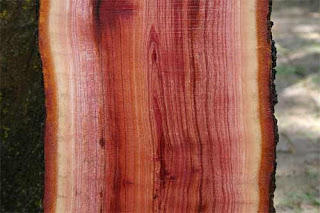Cedrela microcarpa (Syn: Toona ciliata) is a large, fast growing tree, which can grow up to 30 m. tall. Common names are Toon, Toona, Australian Red Cedar, Moulmein cedar, Burma cedar.
It is a deciduous tree with wide spreading branches. The large grown trees have buttress roots which spread quite far from the tree. The bark is rough and brownish grey in colour. The core wood is reddish in colour. Compound leaves of this tree resemble Neem (Azadirachta indica) leaves but are larger. Flowers of Cedrela are white and of tubular shape. Tender fruits of both these trees look similar but Neem fruit is a drupe and the fruit of Cedrela is a capsule. When ripe the Cedrela capsule splits in star shape and tiny, brownish winged seeds are dispersed by wind far and wide. This habit of the tree has made it invasive in some countries. Both Cedrela and Neem tree belong to Meliaceae family. Its origin is supposed to be Australia but now it is naturalized in Tropical Asia, southern China, Himalayas.
Cedrela wood is used for making furniture, carving and inlay work. Its timber is highly valued. However, due to extensive cutting of the trees for its highly valued timber, this tree has diminished in numbers in many countries. The tree is supposed to have certain medicinal uses and is used in Unani and Ayurvedic medicines. Cedrela can be propagated with seeds.
It is a deciduous tree with wide spreading branches. The large grown trees have buttress roots which spread quite far from the tree. The bark is rough and brownish grey in colour. The core wood is reddish in colour. Compound leaves of this tree resemble Neem (Azadirachta indica) leaves but are larger. Flowers of Cedrela are white and of tubular shape. Tender fruits of both these trees look similar but Neem fruit is a drupe and the fruit of Cedrela is a capsule. When ripe the Cedrela capsule splits in star shape and tiny, brownish winged seeds are dispersed by wind far and wide. This habit of the tree has made it invasive in some countries. Both Cedrela and Neem tree belong to Meliaceae family. Its origin is supposed to be Australia but now it is naturalized in Tropical Asia, southern China, Himalayas.
 |
| Tender capsules |
 |
| Capsules |
 |
| Capsules and seeds |
 |
| Seed magnified |
 |
| https://en.wikipedia.org/wiki/Toona_ciliata#/media/File:Cedrela_toona00.jpg |




















